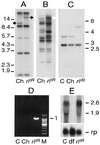High genetic instability of heterochromatin after transposition of the LINE-like I factor in Drosophila melanogaster
- PMID: 9223313
- PMCID: PMC21555
- DOI: 10.1073/pnas.94.15.8052
High genetic instability of heterochromatin after transposition of the LINE-like I factor in Drosophila melanogaster
Abstract
In the present work, we have asked whether a group of 13 essential genes mapping to the heterochromatin of Drosophila melanogaster chromosome 2 are mutable following transposition of the I factor during I-R hybrid dysgenesis. We found that the frequency of lethal events mapping to chromosome 2 heterochromatin is surprisingly high, despite the low density of genetic functions identified in this region compared with euchromatin. Cytogenetic and molecular analyses indicated that the recovered mutations correspond either to insertions or to rearrangements. Moreover, chromosomes bearing specific heterochromatic lethal mutations were generated by recombination in the heterochromatin. Together, these data indicate that I factors transpose with high frequency into pericentric regions of chromosome 2 and may play a role in the evolution of constitutive heterochromatin.
Figures



Similar articles
-
FISH analysis of Drosophila melanogaster heterochromatin using BACs and P elements.Chromosoma. 2003 Jul;112(1):26-37. doi: 10.1007/s00412-003-0241-9. Epub 2003 Jun 25. Chromosoma. 2003. PMID: 12827380
-
Cytogenetic analysis of the second chromosome heterochromatin of Drosophila melanogaster.Genetics. 1991 Mar;127(3):553-64. doi: 10.1093/genetics/127.3.553. Genetics. 1991. PMID: 1707844 Free PMC article.
-
Meiotic recombination is suppressed near the histone-defined border of euchromatin and heterochromatin on chromosome 2L of Drosophila melanogaster.Genome. 2016 Apr;59(4):289-94. doi: 10.1139/gen-2015-0171. Genome. 2016. PMID: 27031007
-
Vital genes in the heterochromatin of chromosomes 2 and 3 of Drosophila melanogaster.Genetica. 2003 Mar;117(2-3):209-15. doi: 10.1023/a:1022996112742. Genetica. 2003. PMID: 12723700 Review.
-
Constitutive heterochromatin and transposable elements in Drosophila melanogaster.Genetica. 1997;100(1-3):85-93. Genetica. 1997. PMID: 9440261 Review.
Cited by
-
Constitutive heterochromatin: a surprising variety of expressed sequences.Chromosoma. 2009 Aug;118(4):419-35. doi: 10.1007/s00412-009-0211-y. Epub 2009 May 2. Chromosoma. 2009. PMID: 19412619 Review.
-
The Analysis of Pendolino (peo) Mutants Reveals Differences in the Fusigenic Potential among Drosophila Telomeres.PLoS Genet. 2015 Jun 25;11(6):e1005260. doi: 10.1371/journal.pgen.1005260. eCollection 2015 Jun. PLoS Genet. 2015. PMID: 26110638 Free PMC article.
-
A genetically marked I element in Drosophila melanogaster can be mobilized when ORF2 is provided in trans.Genetics. 1998 Jan;148(1):267-75. doi: 10.1093/genetics/148.1.267. Genetics. 1998. PMID: 9475738 Free PMC article.
-
Genomic Organization of Repetitive DNA Elements and Its Implications for the Chromosomal Evolution of Channid Fishes (Actinopterygii, Perciformes).PLoS One. 2015 Jun 12;10(6):e0130199. doi: 10.1371/journal.pone.0130199. eCollection 2015. PLoS One. 2015. PMID: 26067030 Free PMC article.
-
Applying mobile genetic elements for genome analysis and evolution.Mol Biotechnol. 2006 Jun;33(2):161-74. doi: 10.1385/MB:33:2:161. Mol Biotechnol. 2006. PMID: 16757803 Review.
References
-
- Finnegan D J. Trends Genet. 1989;5:103–107. - PubMed
-
- Young B S, Passion A, Traverse K L, French C, Pardue M L. Cell. 1983;34:85–94. - PubMed
-
- Kuff E L, Fewell J E, Lueders K K, Di Paolo J A, Amsbaugh S C, Popescu N C. Chromosoma. 1986;93:213–219. - PubMed
-
- Taruscio D, Manuelidis L. Chromosoma. 1991;101:141–156. - PubMed
MeSH terms
Substances
Associated data
- Actions
LinkOut - more resources
Full Text Sources
Molecular Biology Databases

